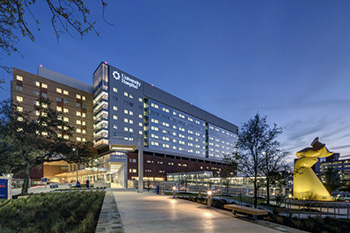UHS Completes Major Capital Improvement Project
 SAN ANTONIO — The University Health System (UHS) is celebrating the completion of the $899 million Capital Improvement Project with the opening of the 1 million-square-foot Sky Tower.
SAN ANTONIO — The University Health System (UHS) is celebrating the completion of the $899 million Capital Improvement Project with the opening of the 1 million-square-foot Sky Tower.
The 10-story Sky Tower includes 84 emergency center treatment positions, of which 10 are trauma rooms, 35 operating rooms and 420 new private rooms. Perkins + Will, with offices in Dallas, designed the building to fit the needs of the growing community with an art-filled, patient-centered design.
Emphasis on Art
The design of the Sky Tower emphasized the integration of local and international art. In a community with a longstanding appreciation for the arts, the incorporation of art was a dual effort between the surrounding community and health system officials. The art installations in the Sky Tower is an important and visible part of the patient, visitor and staff experience, according to Steve Milner, LEED AP, senior medical planner with Perkins + Will.
“The spirit of the art program with this project and this client was to create a familiar and reassuring cultural response, creating a sense of place uniquely San Antonio by employing color, pattern, form and known cues, integrated with the architecture and the site,” Milner said.
 Eight countries and 21 states are represented in the art program. However, the art program placed a large emphasis on local artists with the majority of artists being from the San Antonio area. All framers and installers were also local. Coupled with the inclusion of design enhancement, which Milner defines as development of narrative or lyrical ideas into the building and site, the art in the building is integrated into the construction process as a collaborative engagement between the architect, interior designer, artist and contractor, not simply an after fact measure, Milner said.
Eight countries and 21 states are represented in the art program. However, the art program placed a large emphasis on local artists with the majority of artists being from the San Antonio area. All framers and installers were also local. Coupled with the inclusion of design enhancement, which Milner defines as development of narrative or lyrical ideas into the building and site, the art in the building is integrated into the construction process as a collaborative engagement between the architect, interior designer, artist and contractor, not simply an after fact measure, Milner said.
“When art and architecture meet, there are opportunities to go beyond the common expectations,” Milner said.
A Healing Atmosphere for Patients and Staff
The interior of the Sky Tower promotes a healing atmosphere with abundant daylight, gardens, lounges and extensive views.
“Several studies have linked healthy, sustainable environments as having positive effects on people in those spaces,” Milner said. “Patients have had very positive results in hospital rooms with access to views and daylight, and now research is being used to support improvements to staff environments for positive effects on staff.”
 The design focuses on reducing as many stressors as possible not only for patients, but for staff as well, which is equally important to consider, as patient safety is dependent upon health care staff, Milner said. With the amount of intensity and concentration required of health care staff, the built environment must reflect a calming atmosphere.
The design focuses on reducing as many stressors as possible not only for patients, but for staff as well, which is equally important to consider, as patient safety is dependent upon health care staff, Milner said. With the amount of intensity and concentration required of health care staff, the built environment must reflect a calming atmosphere.
“The project team is focused on creating a healing environment where anxiety and stress are reduced. Positive distraction will provide psychological relief for patients, visitors, and staff,” Milner said. “Employing active and passive design strategies —such as a quality sense of arrival, dedicated staff spaces, both indoor and outdoor, and additional support programs — help encourage staff well-being.”
Sustainable Focus
The building is currently pursuing LEED Gold certification, and with Perkins + Will’s sustainable health care design, the energy-efficient goals aligned with the sustainable integrity of Perkins + Will.
“We saw early on that the health system’s deep level of stewardship to create an environmentally responsible project was very much in alignment with long time missions of Perkins + Will,” Milner said. “UHS was extremely supportive of the sustainable design strategies, systems and technologies that addressed our common goals for the project.”
The building uses one-third less energy than required by code. Sustainable practices include recycled water for landscaping irrigation and rooftop gardens. The gardens contain vegetation and art program sculptures that, in addition to adding to aesthetics, help reduce the radiant heat of the site and reduce demand on the building’s cooling systems, Milner said. The project also maximized the use of local and regional materials.
“The 1 million-square-foot-plus project is a study in how innovative design can maximize resources to minimize environmental impact,” Milner said.
The construction management team for the project was a joint venture between locally based Zachry Construction Corporation, J.T. Vaughn Construction, with offices in San Antonio, and Salt Lake City-headquartered Layton Construction Co.
